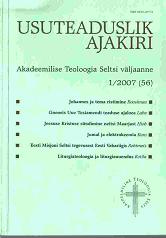Visionääride võim ehk mõningaid aspekte naismüstika teemal XIII–XIV sajandi kontekstis
Power of Visionaries
Author(s): Maris LaanpereSubject(s): Christian Theology and Religion
Published by: Akadeemiline Teoloogia Selts
Keywords: Church History; Mysticism
Summary/Abstract: The present article concerns women who lived in the 13th and 14th centuries in the Western and Southern Europe, being venerated as saints and known in their lifetime as mystics and visionaries. Generally they refused marriage and were hence bestowed with the only acceptable alternative: to remain chaste in order to dedicate their life to God, mostly as a free servant of God. The latter status becomes popular during the 13th century among those who seek a new social and religious identity, and remains as such thereafter. This intense phenomenon of women’s secular sanctity takes place thanks to the foundation of alms seekers’ orders, which open new paths for women on the religious front. These women were quite revolutionary and innovative during their times, because for the first time in the Middle Ages women were able to transmit their prophetic visions and counsel the clergy, and they were also permitted to criticize the religious hierarchy. With the rise of women mystics, their own characteristic language was born: emotional, intimate and erotic, which was very different from that of men who wrote about God. The 13th and 14th centuries should be seen as a progressive period (a kind of renaissance) for women on the social, personal and religious level during the long history of Christian Europe, because for the first time it was possible to hear a woman’s voice in a masculine society.
Journal: Usuteaduslik Ajakiri
- Issue Year: 2008
- Issue No: 1 (57)
- Page Range: 44-64
- Page Count: 21
- Language: Estonian

